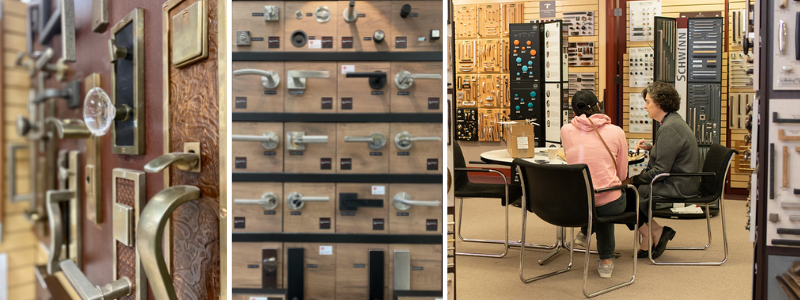Replacing Door Hardware?
There are many elements that go into the design, function, and installation of door hardware. When replacing door hardware, you’ll need to make sure you choose a design that fits within the way your door has been prepped, which varies significantly depending on the style of the original hardware.
Here are some of the basic questions we’ll ask you before determining which hardware will suit your needs, and some background to help you answer them. Having this information on hand before your visit will make sure we can most efficiently guide you to your ideal products!
1. What Type of Door Hardware Are You Replacing?
- Mortise Lock
Mortise locks are of high quality and durable, so they are more expensive to purchase and install than tubular locks. These locks can be very difficult to replace without doing work on the door.- At the turn of the last century, mortise locks came in all sorts of sizes by a variety of manufacturers with different specifications, so it can take expertise to replace them properly. We recommend that you have a professional assist you with the process.
- The technical stuff: Mortise locks require a rectangular cut-out (called a mortise) in the edge of a door. The deadbolt and latch are combined in the cassette. Trim is applied to the surface of the door and connected to the lock.
- What you need to know: Mortise cassettes come in a variety of sizes. When replacing existing or antique mortise locks be sure to verify measurements.
- Tubular Style Lock
Tubular locks are the most common type in today’s construction market. It can be identified by the latch, which has a “tube” appearance.
2. What is the Backset Measurement?
This is the measurement from the center of the hardware to the edge of the door.
- Tubular styles:
Residential applications: 2-3/8″ backset is common
Commercial applications: 2-3/4″ is common. - Mortise locks:
Measurements can vary, but 2-½” is common.
In mid-century homes larger backsets, around 5″, were used to allow for larger, stylish backplates like “stars”.
Some brands have adjustable backsets that toggle between 2-3/8″ and 2-3/4″ to make replacement easier! We have options in stock and for special order – ask your NBH salesperson for the best options for you.
3. What is the Latch Style?
- A latch can be drive-in, round corner, or square corner.
Currently in the USA, square corners are typically associated with a “higher-end look”. The shape of a strike plate will be selected to match with a round or square corner latch. - Drive-in latches do not have a faceplate and are the least expensive to install. Many “stock” doors that come with hardware will have drive-in latches.
Photo from Baldwin, an NBH door hardware vendor. View Baldwin in stock on the NBH website here.
- What you need to know:
- “Drive-in” latches have a collar and do not have a faceplate. Make sure to check if you have a round corner or square corner faceplate if not you do not have a drive-in latch.
- 6-way latch: A special tubular latch that has the option of being drive-in, round corner or square corner. This is a good option to keep in mind when looking for new hardware!
4. What Design Do You Have in Mind for the New Hardware?
If your new hardware selection is a different shape or size from the hardware you’re replacing, you may run into some aesthetic issues. For example, if the new rosette or backplate is narrower or shorter than the original, you might see the old marks on the door. Or, the stain may be darker in places the old hardware covered, as the original finish fades from UV exposure. If you don’t want to paint or stain the door, be careful of the size and shape of your new door hardware.
5. What is Your Door Thickness?
Exterior doors are typically 1-3/4″ thick while interior doors are typically 1-3/8″ thick. Make sure to check this dimension and let your salesperson know. You may need longer or shorter fasteners depending on the dimension.
6. What is the Handing?
Handing refers to the direction of the door swing and what side the hardware is on.
Some brands of door hardware are handed, and some are not. It’s always good to know your handing before choosing a new style! (You determine handing by standing outside of the room/house and facing the door. Whichever side the hinges are on is your handing: ex. If the hinges are on the left, then it is “left-handed”)
Finally, don’t forget the hinges!
You will want your hinges to match with the new door hardware, especially if you are changing the finish.
With a checklist in hand that includes these pieces of information about your current door, you’ll be off to a great start in your hunt for replacement door hardware. Seem like a lot of information? It is, but that doesn’t mean it has to be difficult for you—we’ll help you put it all together! Rely on your NBH team member to expertly and efficiently sort through the details to present you with options that best fit your needs. We work with our vendors to stay up-to-date on their latest designs and technology to make sure you are always informed.
Make an appointment in our showroom to view, test, and touch a variety of door hardware.
Or, give our showroom team a call at (503) 233-5381 to get started on your next project.
 Replacing Door Hardware?
Replacing Door Hardware?
There are many elements that go into the design, function, and installation of door hardware. When replacing door hardware, you’ll need to make sure you choose a design that fits within the way your door has been prepped, which varies significantly depending on the style of the original hardware.
Here are some of the basic questions we’ll ask you before determining which hardware will suit your needs, and some background to help you answer them. Having this information on hand before your visit will make sure we can most efficiently guide you to your ideal products!
1. What Type of Door Hardware Are You Replacing?
- Mortise Lock
Mortise locks are of high quality and durable, so they are more expensive to purchase and install than tubular locks. These locks can be very difficult to replace without doing work on the door.- At the turn of the last century, mortise locks came in all sorts of sizes by a variety of manufacturers with different specifications, so it can take expertise to replace them properly. We recommend that you have a professional assist you with the process.
- The technical stuff: Mortise locks require a rectangular cut-out (called a mortise) in the edge of a door. The deadbolt and latch are combined in the cassette. Trim is applied to the surface of the door and connected to the lock.
- What you need to know: Mortise cassettes come in a variety of sizes. When replacing existing or antique mortise locks be sure to verify measurements.
- Tubular Style Lock
Tubular locks are the most common type in today’s construction market. It can be identified by the latch, which has a “tube” appearance.
2. What is the Backset Measurement?
This is the measurement from the center of the hardware to the edge of the door.
- Tubular styles:
Residential applications: 2-3/8″ backset is common
Commercial applications: 2-3/4″ is common. - Mortise locks:
Measurements can vary, but 2-½” is common.
In mid-century homes larger backsets, around 5″, were used to allow for larger, stylish backplates like “stars”.
Some brands have adjustable backsets that toggle between 2-3/8″ and 2-3/4″ to make replacement easier! We have options in stock and for special order – ask your NBH salesperson for the best options for you.
3. What is the Latch Style?
- A latch can be drive-in, round corner, or square corner.
Currently in the USA, square corners are typically associated with a “higher-end look”. The shape of a strike plate will be selected to match with a round or square corner latch. - Drive-in latches do not have a faceplate and are the least expensive to install. Many “stock” doors that come with hardware will have drive-in latches.
Photo from Baldwin, an NBH door hardware vendor. View Baldwin in stock on the NBH website here.
- What you need to know:
- “Drive-in” latches have a collar and do not have a faceplate. Make sure to check if you have a round corner or square corner faceplate if not you do not have a drive-in latch.
- 6-way latch: A special tubular latch that has the option of being drive-in, round corner or square corner. This is a good option to keep in mind when looking for new hardware!
4. What Design Do You Have in Mind for the New Hardware?
If your new hardware selection is a different shape or size from the hardware you’re replacing, you may run into some aesthetic issues. For example, if the new rosette or backplate is narrower or shorter than the original, you might see the old marks on the door. Or, the stain may be darker in places the old hardware covered, as the original finish fades from UV exposure. If you don’t want to paint or stain the door, be careful of the size and shape of your new door hardware.
5. What is Your Door Thickness?
Exterior doors are typically 1-3/4″ thick while interior doors are typically 1-3/8″ thick. Make sure to check this dimension and let your salesperson know. You may need longer or shorter fasteners depending on the dimension.
6. What is the Handing?
Handing refers to the direction of the door swing and what side the hardware is on.
Some brands of door hardware are handed, and some are not. It’s always good to know your handing before choosing a new style! (You determine handing by standing outside of the room/house and facing the door. Whichever side the hinges are on is your handing: ex. If the hinges are on the left, then it is “left-handed”)
Finally, don’t forget the hinges!
You will want your hinges to match with the new door hardware, especially if you are changing the finish.
With a checklist in hand that includes these pieces of information about your current door, you’ll be off to a great start in your hunt for replacement door hardware. Seem like a lot of information? It is, but that doesn’t mean it has to be difficult for you—we’ll help you put it all together! Rely on your NBH team member to expertly and efficiently sort through the details to present you with options that best fit your needs. We work with our vendors to stay up-to-date on their latest designs and technology to make sure you are always informed.
Make an appointment in our showroom to view, test, and touch a variety of door hardware.
Or, give our showroom team a call at (503) 233-5381 to get started on your next project.




